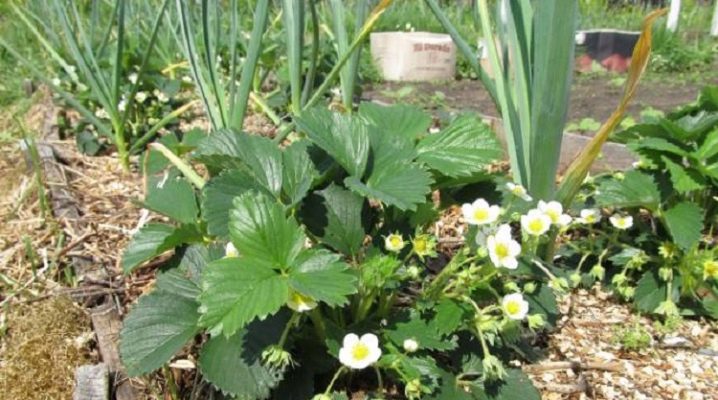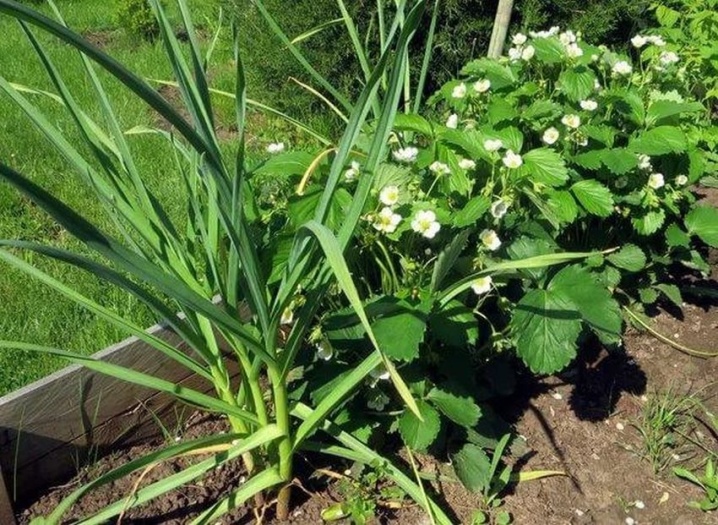Is it possible to plant garlic in strawberries and how to care for the garden bed?

How to save space when the site is small? Can you, for example, plant more garlic on a strawberry garden? And why do those who do not have a deficit in land do this anyway? From the material of the article, you will find out whether it is possible to plant garlic in strawberries and how to care for such a bed, and we will also tell you about the advantages and disadvantages of such a neighborhood.

Pros and cons of landing
As it turned out, the hot vegetable feels great in a strawberry garden. Garlic even contributes to higher strawberry yields, so the crops are compatible, and this neighborhood is of mutual benefit.
You can safely plant garlic in strawberries if you want to get clean berries, without "chemistry".
Obviously, this compatibility has more advantages than disadvantages:
- rational use of land;
- no need to apply chemical fertilizers to feed strawberries;
- collection of environmentally friendly crops;
- preventing soil depletion;
- saving on fertilizers;
- protecting strawberries from pests and diseases.

Garlic is considered a natural insecticide, planting it next to strawberries protects the berry crop from the following pests:
- aphids;
- bear;
- ants of various kinds;
- spider mites;
- wireworm and slugs;
- strawberry weevils, etc.


The fungicidal properties of garlic help strawberries to cope with the following diseases:
- late blight and fusarium;
- rot of different colors (gray, white, etc.);
- powdery mildew;
- white spot;
- anthracnose, etc.
Among the minuses, perhaps only the doubt that some gardeners express: they say, garlic does not help strawberries, but, on the contrary, only leads to her "trail". Pests allegedly bypass the burning culture and "stick" with double zeal to berry bushes.
In addition, as opponents of the garlic-strawberry neighborhood argue, these crops have a common enemy - the nematode.

This is a pest that eats both strawberries and garlic equally gluttonously, and all plants die. It is almost impossible to see them just like that (they breed and live at the level of the roots), therefore, summer residents are often surprised when seedlings die.
And they simply suck the juice from the plants through the root system, the latter wither and at best they simply will not bear fruit, at worst they will die. How plausible this version is, everyone can check on their site by planting garlic in a strawberry garden.
By the way, supporters of such a neighborhood say that strawberries also help garlic: near it, the latter forms stronger and larger heads. And against a common enemy there is a sure way - to plant marigolds, chrysanthemums or calendula nearby.

You can simply spread the tops of these flowering plants between strawberry bushes and garlic. So there are more advantages in favor of joint planting, and therefore many immediately after planting strawberries take up the spread of burning culture between berry bushes.

How to plant correctly?
The agrotechnology of growing garlic along with strawberries is quite simple. The planting of the cloves is carried out as follows:
- choose winter garlic cloves for planting (although spring garlic is also suitable, subject to certain rules);
- between the bushes of garden strawberries and holes loosen the soil;
- plant garlic in loose soil to a depth of 4–6 cm;
- then you need to mulch the plantings (for this they take compost or humus, mix with ash);
- in the end, they build an additional shelter of straw (fallen leaves or mown grass are also suitable for this business).
It is best to place the garlic rows in the aisle of the strawberry bushes. Some summer residents do not immediately mulch the planting, but pour wood ash mixed with the ground into the recesses. By the way, they are in no hurry to water the immediately planted teeth (if it is winter garlic).

Mineral dressing is carried out in the fall, it is believed that in this way the garlic gains strength for further growth, and in the spring it is fed with an organic composition and a little more mineral - this is already more necessary for the formation of beautiful heads.
Winter varieties are planted by mid-October, when the entire strawberry harvest is fully harvested and all measures have been taken to prepare the crop for wintering.

Such garlic emerges early (by April) and subsequently forms large heads with a diameter of 6-8 cm. All summer, except for the arrows, you can eat the vitamin tops of garlic without touching the underground part. If you dig up all the garlic, then a new planting is to come from the new season. Growing strawberries and garlic together or not is the choice of every gardener.
We must also take into account the growing conditions. If it is not possible to do this on one plantation, then you can place the garlic beds next to the strawberries: garlic phytoncides in any case will do their job for the berry culture.

Garden bed care
They take care of garlic growing on the same plantation with strawberries, in the same way as if the culture grew alone: timely watering is important, it is necessary to loosen it, apply top dressing. Only all agrotechnical measures are carried out very carefully so as not to "alarm" the neighbor.
By the way, opponents of joint planting argue that it is in no way possible to work carefully under the condition of the neighborhood, that strawberry roots will still touch each time when loosening the soil, when digging up garlic, even when planting it. But it depends on the gardener.

To get large heads of garlic, you need to break off the arrows. They do not need to be thrown away - they are suitable for food: they are stewed, fried, blanched, they can be frozen for the winter, or simply prepared an infusion against garden pests. They contain garlic esters, which are detrimental to many diseases and harmful garden and garden creatures.
By the way, if the garlic is planted only to protect the strawberries and create a favorable environment for its development and fruiting, then you should not pay so much attention to care and do not need to dig it up for the winter. If left in the soil, by the spring it will sprout healing shoots for strawberries.
Many gardeners only partially harvest from such garlic plantings, as they say, they dig for themselves, but mainly grow garlic in strawberries specifically to get a good harvest of berries.

If strawberries are primary, then care may not be so thorough, garlic is picky and will sprout anyway.
The only condition, perhaps, that needs to be met is regular watering. But strawberries will not develop well without this: both berry crops and garlic crops like moist soil. If it is hot, then you need to water in 3-4 days, if the weather is rainy, it is enough once every 5-7 days or depending on weather conditions.














The comment was sent successfully.